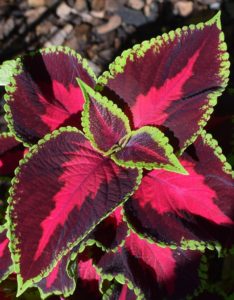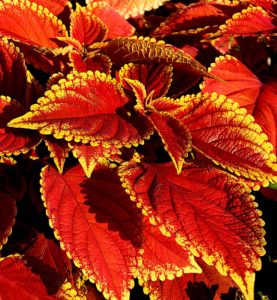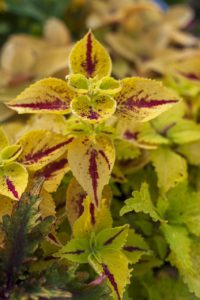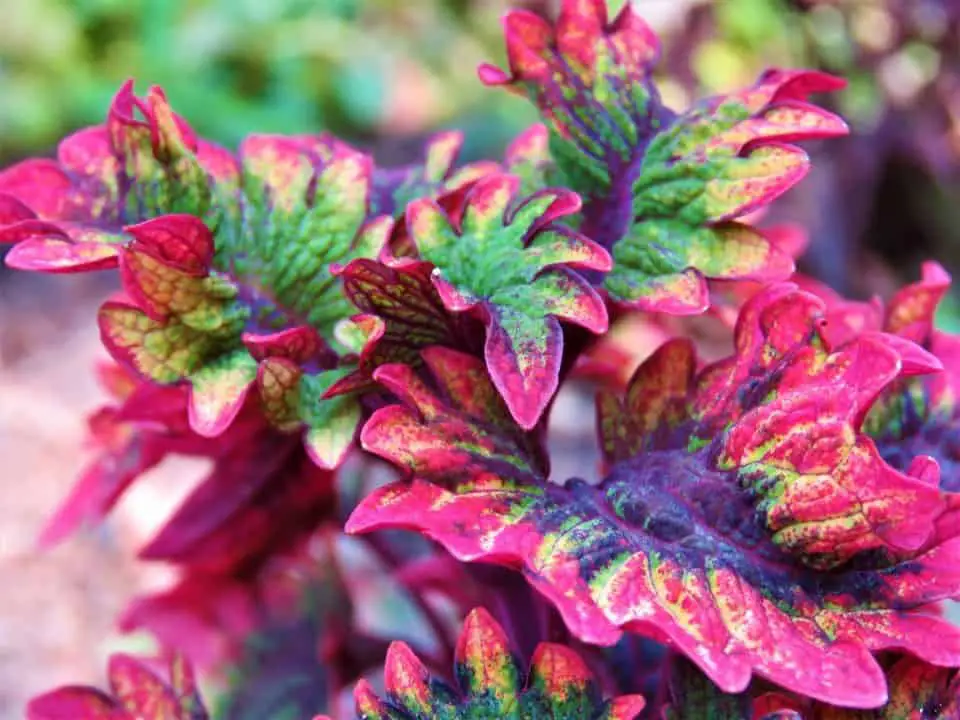Some links in the post are affiliate links and I get a commission from purchases made through some links found in the post.
Coleus (Solenostemon scutellarioides) is a group of perennial shrubs related to the mint family. They aren’t famous for their flowers.
Rather they are prized for their beautiful and vibrant foliage. There is an abundant variety of color schemes to choose from.
This unique quality has made them a favorite for different landscaping ideas. The bright green leaves with shades of burgundy make Coleus an absolute must for a colorful garden.
Most gardeners find these plants very easy to grow. They require very little care and can grow anywhere.
For this reason, they are extensively used as bedding, border, and container plants.
They do exceptionally well in stand-alone pots and can be used to create beautiful shade gardens.
What Factors Should You Consider When Planting with Coleus in a Container
The following factors must be kept in mind when selecting companions for your coleus:
1) Color Contrast
The main goal should be to find a plant with contrasting colors with coleus. Using this strategy can make your container and pots very attractive.
You can either choose coleus plants to border the container or can make them the center of attention.
2) Same Growth Requirements
The plants used in the container should essentially thrive in the same type of environment. The coleus plants don’t tolerate full sun and overwatering.
They are very prone to diseases like root rot. For that purpose, they should be paired up with similar shade requiring plants.
What to Plant with Coleus in a Container?
 The following plants can be used with coleus plant in a container in a very fashionable way:
The following plants can be used with coleus plant in a container in a very fashionable way:
1) Impatiens
3) Begonias
4) Hostas
5) Sweet Potato Vine
7) Burning Bush Coleus and Fuchsia
8) Florida Sun Rose Coleus and Green Fuchsia
1) Impatiens and Coleus Plant Combination in a Container
Impatiens are annual plants that are known for their bright and cheerful flowers in the spring. They alternate with the perennial plants in bloom.
This makes your shade garden look colorful year-round. They are wonderful when used in combination with Coleus.
As flower borders, the impatiens can add more color to the bright lush foliage of your coleus.
The blooming flowers stand out perfectly from the leaves and present a perfect picture. Both white and red impatiens can be used for making this combination.
2) Salvia Plants and Coleus Plant Combination in a Container
Salvia plants also belong to the mint family. They provide the gardeners with a wider variety of colors to choose from.
The most common variety used is “wood land sage”. It sports beautiful purple flowers in spring which look graceful.
They are widely used with coleus plants in containers to create an ideal background. The most common variety of coleus used in this combination is the “Big Chief”.
The leaves of this variety are light green with a brownish center. The purple lavender flower spikes of the salvias show a nice contrast in this combination.
This plant mix can work well both in cool or warm weather.
3) Begonias and Coleus Plant Combination in a Container
Begonias are shrubby perennials that are ideal for growing pots and hanging baskets.
Unlike most flowering plants, which like to grow in full sun, begonias prefer growing up well in the shade.
They flower for extended periods and brighten up the shady areas with their colorful blooms. Both begonia and coleus have similar growth requirements.
They make the perfect combo to grow alongside in a container or a shade garden.
The combination looks dazzling when the coleus is planted along the edge of the container with begonias in the center.
With proper care, these plants will display a never-ending feast throughout the whole winter.
4) Hostas and Coleus Plant Combination in a Container
Hostas (Funkia) are shade-loving plants that grow easily with plants requiring similar conditions.
They grow easily in the dark spots where most plants can’t. Their colorful foliage, hardiness, and easy growth make them ideal to pair with coleus plants.
They make a unique combination and adding hosta plants provides a more colorful exuberance.
if you’re enjoying this article, check out our article on what are good companion plants for a creeping jenny.
5) Sweet Potato Vine and Coleus Plant Combination in a Container
Sweet potato vines (Ipomoea batatas) can grow practically in any condition ranging from full sun to complete shade.
They are used extensively as accent plants due to their mesmerizing foliage. They are very versatile and are quite resistant to pests and diseases.
The plants are loved for their colorful leaves which can be purple, green, or black. Sweet potato vines make great companion plants both in containers and the raised beds.
And since the foliage isn’t affected by the changing weather, you can enjoy this plant all year long without worrying about its blooming.
They prove to be a wonderful match with coleus. When used in combination, they provide a lush appearance through their texture and foliage.
Coleus can be placed in the center of the container while the vines can provide a colorful border.
This combination can also be used in hanging baskets where the dangling vines show an even more spectacular display.
6) Fountain Grass and Coleus Plant Combination in a Container
 Fountain grass (Pennisetum) is an ornamental grass that is widely used for landscaping. It is called fountain grass due to its gracefully spaced out slender leaves.
Fountain grass (Pennisetum) is an ornamental grass that is widely used for landscaping. It is called fountain grass due to its gracefully spaced out slender leaves.
The cascading appearance makes it all worthwhile. There are many different types of fountain grass. Most of them are found naturally in tropical areas of Africa and Asia.
Purple fountain grass is the hot pick for most of the gardens.
The beauty of this grass makes it an ideal choice to be used as a companion plant in containers and shade gardens.
Planting it with coleus is a popular combination. The bottle-brush flowers and spiky leaves provide a unique look when planted alongside coleus.
7) Combination of Burning Bush Coleus and Fuchsia
This variety of coleus has bright orange leaves which adds a unique tinge to the mix. The perfect plant to go with this includes the Gartenmeister Fuchsia.
This fuchsia, with its coral red flowers and dark leaves, shows a deep contrast to the bright coleus.
It is also a shade loving plant and performs exceptionally well in containers. The soil should be moist for this setting but not soggy at all.
8) Florida Sun Rose Coleus and Green Fuchsia
This type of coleus has attractive burgundy vegetation. It is a relatively low maintenance plant and can be effectively used with other bright plants for a vibrant show.
The “Billy Green” Fuchsia is a wonderful companion plant for this purpose. The olive green foliage and the pink tubular flowers make the combination look really aesthetic.
How to Care for Coleus Plant in a Container
Following things should be taken care of to ensure the healthy growth of your Coleus:
1) Light
Coleus are shade-loving plants and abhor direct light. These plants prefer bright indirect sunlight.
If placed directly in the full sun, the leaves become bleached and dull in appearance. Use only sun-tolerant varieties if you plan on putting your containers under the broad daylight.
2) Watering
Whether you have your coleus in containers or planted directly in the soil, always water it in a moderate amount.
Coleus plants don’t like to be overwatered and can quickly develop root rot if they are. The container plants need more frequent watering as compared to planted ones.
3) Humidity
As these are naturally found in tropical areas, the coleus plants love to flourish in moderate humidity levels.
High humidity levels aren’t needed and they will do just fine in 60-80% humidity levels.
4) Soil
High-quality soil should be preferred when planting coleus in containers. The soil should be rich in nitrogen and have a pH of around 6 to 7.
The containers should also be well-drained to prevent clogging up of water. For that purpose, adequate drainage holes should be present beneath the containers.
5) Pruning
If the plant is let loose without any pruning, it can present a very shriveled appearance.
It is necessary to prune your coleus from time to time to prevent it from becoming leggy and unattractive.
Use sterile shears for this purpose and cut the tops to ensure more lateral growth of the plant.
Final Thoughts: What to Plant with Coleus in a Container?
 Coleus plants are complete gems when it comes to using them in containers.
Coleus plants are complete gems when it comes to using them in containers.
They are essential parts of every shade garden you can find. Using them with other contrast plants is a sure way to light up every dark spot in your lawn.
By following the above strategies, I am sure you can devise a beautiful layout for your container garden.
Furthermore, you can experiment with different plants yourself. This may result in some unique combinations that might surprise you as well!
Before you go, here are some more related articles I encourage you to read below to help solve more of your gardening issues:
5 Great Planting Combinations With Your Agapanthus
Are Bamboo Pots Good For Plants
How To Landscape With Potted Plants
About the Author:
Saad Ansar
Saad is an avid gardener himself and is a great lover of plants, animals, photography, & people. Currently, he is focused on photographing indoor plants & captioning beautiful outdoor sceneries. He writes and rewrites in-depth articles on nature and science.


